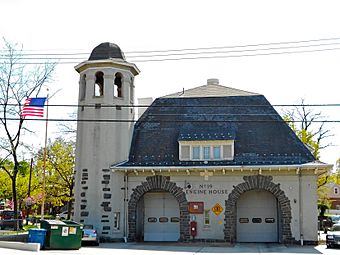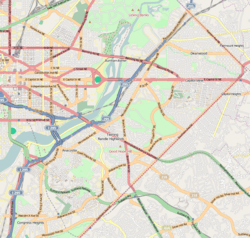Engine Company 19 (Washington, D.C.) facts for kids
Quick facts for kids |
|
|
Engine Company No. 19
|
|
 |
|
| Location | 2813 Pennsylvania Ave., SE Washington, D.C. |
|---|---|
| Area | less than one acre |
| Built | 1910 |
| Architect | Averill and Adams |
| MPS | Firehouses in Washington DC MPS |
| NRHP reference No. | 10000238 |
| Added to NRHP | May 10, 2010 |
Engine Company No. 19 is a really old and special fire station located in the Randle Highlands neighborhood of Southeast Washington, D.C.. This building was recognized as an important historic place in Washington, D.C., in 2009. A year later, in 2010, it was added to the National Register of Historic Places, which is a special list of important places across the country.
History of Engine Company No. 19
The very first fire station built east of the Anacostia River was in 1898. Engine Company No. 19 was the fourth fire station built in that area, opening its doors in 1910. It was designed by a famous architectural company from Washington, D.C., called Averill and Adams.
The building has a mix of different architectural styles, especially French designs. This was because the city's architect office wanted each new fire station to look unique and special. At that time, this part of Washington, D.C., was considered an area outside the main city. It didn't have city water pipes or fire alarms yet. Because of this, a special fire company called Chemical Company Number 2 was based here.
The fire station also had a tall hose tower. This tower wasn't just for drying hoses; it was also used as a lookout post. Firefighters could climb up and spot fires from a distance.
From Horses to Motors
On January 1, 1921, Chemical Company Number 2 changed into a regular fire engine company and became Engine Company 19. This was part of a bigger change where all the city's special chemical companies became regular engine companies.
A few years later, in 1925, Engine Company 19 made another big change. It was the very last fire station in the entire department to stop using horses to pull its fire trucks. Instead, they started using motorized vehicles, which were much faster and more modern!
Images for kids




